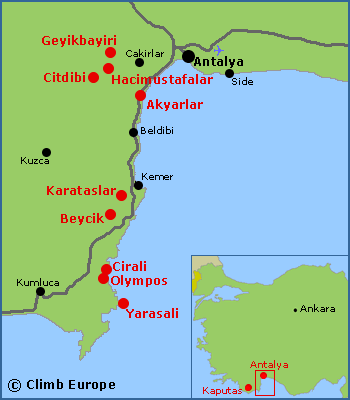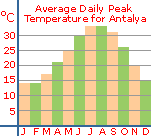Rock Climbing in Antalya
The Antalya area is the best and most extensive rock climbing area in Turkey, particularly the crags of Geyikbayiri and Olympos.
| Crag | Total No. of Routes | Up to 5c+ | 6a to 6b+ | 6c to 7a+ | 7b to 7c | over 7c+ |
|---|---|---|---|---|---|---|
| Geyikbayiri | 1042 | 157 | 287 | 276 | 184 | 138 |
| Citdibi | 121 | 4 | 11 | 17 | 24 | 65 |
| Hacimustafalar | 9 | 0 | 0 | 1 | 1 | 7 |
| Akyarlar | 15 | 7 | 4 | 4 | 0 | 0 |
| Karataslar | 70 | N/N | N/N | N/N | N/N | N/N |
| Beycik | 58 | 18 | 19 | 15 | 6 | 0 |
| Olympos | 311 | 56 | 93 | 81 | 39 | 42 |
| Cirali | 77 | 21 | 21 | 17 | 8 | 10 |
| Yarasali | 18 | 1 | 9 | 5 | 2 | 1 |
| Kaputas | 17 | 2 | 7 | 7 | 0 | 1 |
Map of the Rock Climbing areas around Antalya

Sport climbing at Geyikbayiri
Geyikbayiri is the largest sport climbing area in Turkey. The crag itself is situated 25km from the busy tourist city of Antalya, with the only "tourists" being rock climbers! The main crag is 1.5km long, plus several other buttresses, providing over 1,000 routes across at all grades. However there is still potential to develop many more! The climbing is on superb limestone rock, with many features such as slabs and faces with small crimps to bomber overhanging tufas and roofs. The majority of the routes are single pitch though there are some 2-pitch routes as well. The crag has only been developed since 2001 and therefore all of the routes have good quality bolts.
Citdibi has been nicknamed by the locals as “mini Ceuse”. This is due to the fact that many of the routes are hard (F6c to F9a) that typifies a crag with long stalactites and is mainly overhanging. There are currently over 120 routes here, however there is massive scope to develop many more, and Citdibi is looked upon as the future of Antalya climbing.
Further inland from Geyikbayiri and high up in the mountains (2000m high) at a place called Feslekan Yayla is a fantastic limestone bouldering area. Though the bouldering is not fully developed, it does mean there are great opportunities to bag some first ascents. It is also an excellent place to escape the summer heat of Geyikbayiri.
Sport climbing at Olympos
Further south is another excellent sport climbing area at Olympos along with nearby Cirali. These 2 areas consist of several crags with almost 400 routes on perfect limestone rock across all grades. The rock climbing has slabs with small pockets that require technical moves and lots of balance through to tufas and huge roofs. Some of the crags also have the advantage of only being a few hundred metres from the beach.
Further south is the deep water soloing (DWS) area of Yarasali. The routes are between 8 to 20m long on overhanging limestone rock featuring tufas and pockets. The only downside is that these walls can only be approached by boat that can be hired from Olympos (approximately 1 hour each way).

An unknown climber on Alice in Wunderland, F6a, at the Guzel Manzara sector of Geyikbayiri crag
Other small climbing areas near Antalya
Akyarlar is a small limestone crag, but it has the advantage that the climbing is straight off the beach! There are 15 short, bolted routes here, ranging from 5b+ to 7a and plenty of bouldering.
Beycik sits at an altitude of 450m and faces north/northeast, and therefore is in the shade for most of the day. There are 58 limestone sport routes mostly in the easy to medium difficulty.
The rock climbing at Karataslar is made up of 10 conglomerate towers with 70 routes ranging from 10m to 150m in length.

Antalya Rock Climbing Logistics and Beta
Guidebook - The climbing guidebook for the area is called "Antalya Kaya Tirmanis Rehberi/A Rock Climbing Guide Antalya", written by Ozturk Kayikci. The guidebook covers almost 1,600 routes and includes all the main crags in the Antalya area, these being: Geyikbayiri, Citdibi and Hacimustafalar in the mountains; and Akyarlar, Beycik, Olympos, Cirali, Yarasali and Kaputas on the coast. This guidebook is available to buy from our shop.
Getting to Antalya - With many low cost airlines flying into Antalya airport, this is a great place for a budget rock climbing holiday. Geyikbayiri is situated 500m above sea level, making it less humid and cooler than Antalya.
When to visit - The best time to visit both Geyikbayiri and Olympos for rock climbing is from September through to June, though the rainy season is December and January. The exception to this is the crag at Citdibi. The crag faces east and is at an altitude of 1,000m, which means the best time to climb here, is from June to the end of December.
Accommodation - There are a number of campsites/bungalows to rent at Geyikbayiri and Olympos. There are many tourist areas/package destinations around Antalya such as Kemer and Side, which offer cheap hotel/apartment accommodation. These are a good place to stay if you are planning to do a few days climbing as part of your general holiday.
Rock climbing school - For guided or instructed climbing holidays in Antalya we recommend our friends at Climbing Antalya
Bolt Fund – The bolting of new routes and more importantly the re-bolting of existing routes, improving trails and cleaning crags require an investment of time and money. Fortunately, there is a team of volunteers who do this on our behalf, but they rely on donations to the local bolt fund to carry on this great work. These donations will be used directly to buy bolts, anchors and fixed quickdraws. If you want to make a donation, please leave a donation in the various Bolting-Donation-Boxes or buy the Geyikbayiri Brush in one of the local shops in Geyikbayiri. For more information see Bolting Antalya.